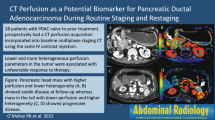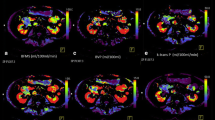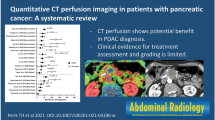Abstract
Objectives
To prospectively evaluate if the perfusion parameters of gastric cancer can provide information on histologic subtypes of gastric cancer.
Methods
We performed preoperative perfusion CT (PCT) and curative gastrectomy in 46 patients. PCT data were analysed using a dedicated software program. Perfusion parameters were obtained by two independent radiologists and were compared according to histologic type using Kruskal–Wallis, Mann–Whitney U test and receiver operating characteristic analysis. To assess inter-reader agreement, we used intraclass correlation coefficient (ICC).
Results
Inter-reader agreement for perfusion parameters was moderate to substantial (ICC = 0.585–0.678). Permeability surface value of poorly cohesive carcinoma (PCC) was significantly higher than other histologic types (47.3 ml/100 g/min in PCC vs 26.5 ml/100 g/min in non-PCC, P < 0.001). Mean transit time (MTT) of PCC was also significantly longer than non-PCC (13.0 s in PCC vs 10.3 s in non-PCC, P = 0.032). The area under the curve to predict PCC was 0.891 (P < 0.001) for permeability surface and 0.697 (P = 0.015) for MTT.
Conclusion
Obtaining perfusion parameters from PCT was feasible in gastric cancer patients and can aid in the preoperative imaging diagnosis of PCC-type gastric cancer as the permeability surface and MTT value of PCC type gastric cancer were significantly higher than those of non-PCC.
Key points
• Obtaining perfusion parameters from PCT was feasible in patients with gastric cancer.
• Permeability surface and MTT were significantly higher in poorly cohesive carcinoma (PCC).
• Permeability surface, MTT can aid in the preoperative imaging diagnosis of PCC.



Similar content being viewed by others
References
Parkin DM, Bray F, Ferlay J, Pisani P (2005) Global cancer statistics, 2002. CA Cancer J Clin 55:74–108
Yao J, Yang ZG, Chen HJ, Chen TW, Huang J (2011) Gastric adenocarcinoma: can perfusion CT help to noninvasively evaluate tumor angiogenesis? Abdom Imaging 36:15–21
Hu B, El Hajj N, Sittler S, Lammert N, Barnes R, Meloni-Ehrig A (2012) Gastric cancer: classification, histology and application of molecular pathology. J Gastrointest Oncol 3:251–261
Li ZS, Li Q (2011) The latest 2010 WHO classification of tumors of digestive system. Zhonghua Bing Li Xue Za Zhi 40:351–354
Ribeiro MM, Sarmento JA, Sobrinho Simoes MA, Bastos J (1981) Prognostic significance of Lauren and Ming classifications and other pathologic parameters in gastric carcinoma. Cancer 47:780–784
Hass HG, Smith U, Jager C et al (2011) Signet ring cell carcinoma of the stomach is significantly associated with poor prognosis and diffuse gastric cancer (Lauren's): single-center experience of 160 cases. Onkologie 34:682–686
Su JS, Chen YT, Wang RC, Wu CY, Lee SW, Lee TY (2013) Clinicopathological characteristics in the differential diagnosis of hepatoid adenocarcinoma: a literature review. World J Gastroenterol 19:321–327
Berlth F, Bollschweiler E, Drebber U, Hoelscher AH, Moenig S (2014) Pathohistological classification systems in gastric cancer: diagnostic relevance and prognostic value. World J Gastroenterol 20:5679–5684
Kwon KJ, Shim KN, Song EM et al (2014) Clinicopathological characteristics and prognosis of signet ring cell carcinoma of the stomach. Gastric Cancer 17:43–53
Kim JP, Kim SC, Yang HK (1994) Prognostic significance of signet ring cell carcinoma of the stomach. Surg Oncol 3:221–227
Piessen G, Messager M, Leteurtre E, Jean-Pierre T, Mariette C (2009) Signet ring cell histology is an independent predictor of poor prognosis in gastric adenocarcinoma regardless of tumoral clinical presentation. Ann Surg 250:878–887
Henson DE, Dittus C, Younes M, Nguyen H, Albores-Saavedra J (2004) Differential trends in the intestinal and diffuse types of gastric carcinoma in the United States, 1973-2000: increase in the signet ring cell type. Arch Pathol Lab Med 128:765–770
Cunningham SC, Kamangar F, Kim MP et al (2005) Survival after gastric adenocarcinoma resection: eighteen-year experience at a single institution. J Gastrointest Surg 9:718–725
Novotny AR, Schuhmacher C, Busch R, Kattan MW, Brennan MF, Siewert JR (2006) Predicting individual survival after gastric cancer resection: validation of a U.S.-derived nomogram at a single high-volume center in Europe. Ann Surg 243:74–81
Miles KA, Griffiths MR (2003) Perfusion CT: a worthwhile enhancement? Br J Radiol 76:220–231
Yi CA, Lee KS, Kim EA et al (2004) Solitary pulmonary nodules: dynamic enhanced multi-detector row CT study and comparison with vascular endothelial growth factor and microvessel density. Radiology 233:191–199
Meijerink MR, van Waesberghe JH, van der Weide L, van den Tol P, Meijer S, van Kuijk C (2008) Total-liver-volume perfusion CT using 3-D image fusion to improve detection and characterization of liver metastases. Eur Radiol 18:2345–2354
Chen TW, Yang ZG, Li Y, Li ZL, Yao J, Sun JY (2009) Quantitative assessment of first-pass perfusion of oesophageal squamous cell carcinoma using 64-section MDCT: initial observation. Clin Radiol 64:38–45
Zhang H, Pan Z, Du L et al (2008) Advanced gastric cancer and perfusion imaging using a multidetector row computed tomography: correlation with prognostic determinants. Korean J Radiol 9:119–127
Satoh A, Shuto K, Okazumi S et al (2010) Role of perfusion CT in assessing tumor blood flow and malignancy level of gastric cancer. Dig Surg 27:253–260
Yao J, Yang ZG, Chen TW, Li Y, Yang L (2010) Perfusion changes in gastric adenocarcinoma: evaluation with 64-section MDCT. Abdom Imaging 35:195–202
Lee DH, Kim SH, Im SA, Oh DY, Kim TY, Han JK (2016) Multiparametric fully-integrated 18-FDG PET/MRI of advanced gastric cancer for prediction of chemotherapy response: a preliminary study. Eur Radiol 26:2771–2778
Bang YJ, Van Cutsem E, Feyereislova A et al (2010) Trastuzumab in combination with chemotherapy versus chemotherapy alone for treatment of HER2-positive advanced gastric or gastro-oesophageal junction cancer (ToGA): a phase 3, open-label, randomised controlled trial. Lancet 376:687–697
Brix G, Bahner ML, Hoffmann U, Horvath A, Schreiber W (1999) Regional blood flow, capillary permeability, and compartmental volumes: measurement with dynamic CT--initial experience. Radiology 210:269–276
Raghunand N, Gatenby RA, Gillies RJ et al (2003) Microenvironmental and cellular consequences of altered blood flow in tumours. Br J Radiol 76(Spec No 1):S11–S22
Fukui Y (2014) Mechanisms behind signet ring cell carcinoma formation. Biochem Biophys Res Commun 450:1231–1233
Kim DY, Park YK, Joo JK et al (2004) Clinicopathological characteristics of signet ring cell carcinoma of the stomach. ANZ J Surg 74:1060–1064
Kim SH, Kim MA, Shin CI, Han JK, Choi BI (2015) CT differentiation of poorly-differentiated gastric neuroendocrine tumours from well-differentiated neuroendocrine tumours and gastric adenocarcinomas. Eur Radiol 25:1946–1957
Goh V, Halligan S, Bartram CI (2007) Quantitative tumor perfusion assessment with multidetector CT: are measurements from two commercial software packages interchangeable? Radiology 242:777–782
Kudo K, Sasaki M, Yamada K et al (2010) Differences in CT perfusion maps generated by different commercial software: quantitative analysis by using identical source data of acute stroke patients. Radiology 254:200–209
Kim SH, Kamaya A, Willmann JK (2014) CT perfusion of the liver: principles and applications in oncology. Radiology 272:322–344
Author information
Authors and Affiliations
Corresponding author
Ethics declarations
Guarantor
The scientific guarantor of this publication is Se Hyung Kim.
Conflict of interest
The authors of this manuscript declare no relationships with any companies whose products or services may be related to the subject matter of the article.
Funding
The authors state that this study was supported by Basic Science Research Program through the National Research Foundation of Korea (NRF) funded by the Ministry of Science, ICT& Future Planning (NRF-2016R1A2B4007762) and by Seoul National University Hospital Research Fund No. 04-2015-620.
Statistics and biometry
No complex statistical methods were necessary for this paper.
Ethical approval
Institutional review board approval was obtained.
Informed consent
Written informed consent was obtained from all patients in this study.
Methodology
• prospective
• observational
• performed at one institution
Electronic supplementary material
Below is the link to the electronic supplementary material.
ESM 1
(DOCX 15 kb)
Rights and permissions
About this article
Cite this article
Lee, D.H., Kim, S.H., Joo, I. et al. CT Perfusion evaluation of gastric cancer: correlation with histologic type. Eur Radiol 28, 487–495 (2018). https://doi.org/10.1007/s00330-017-4979-5
Received:
Revised:
Accepted:
Published:
Issue Date:
DOI: https://doi.org/10.1007/s00330-017-4979-5




